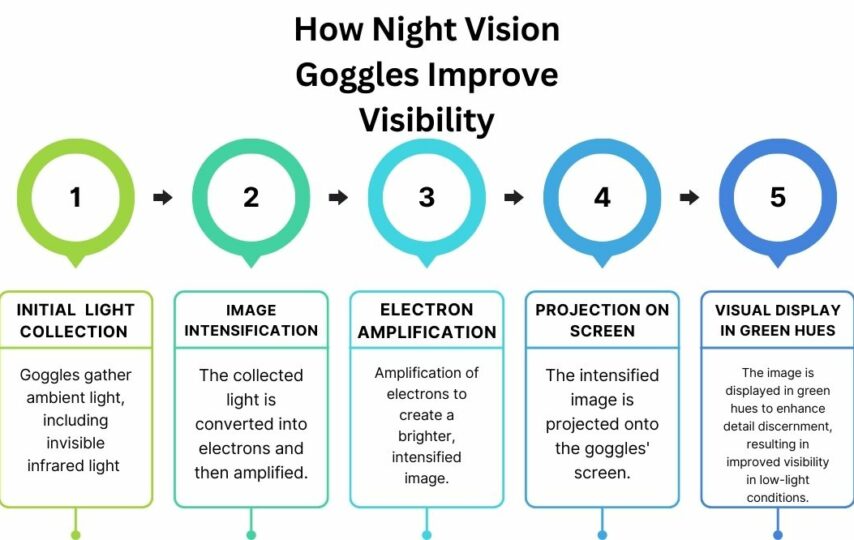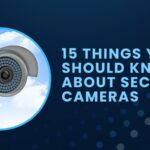When night falls and darkness covers everything, seeing becomes a challenge. This is where night vision goggles (NVGs) come into play, offering a window of clarity in the pitch black.
These goggles are more than just high-tech gear for soldiers or characters in spy movies. They are essential tools used in many professions, from piloting planes at night to conducting search and rescue missions.
In this article, we’ll look closely into NVGs. Let’s explore how they light up the dark and why they’re crucial for tasks that extend into the night.
Understanding Night Vision Technology
Night vision goggles (NVGs) significantly improve visibility in low-light or dark environments, a feature that’s particularly useful in various professional and recreational contexts.
Amplification of light
NVGs work primarily by amplifying existing light, such as starlight or moonlight, to levels perceivable by the human eye. Even in minimal light, these devices can enhance visibility by intensifying the available light.
Infrared light detection
Many NVGs are equipped to detect infrared light, which is invisible to the naked eye. This ability allows users to see in the dark as NVGs convert infrared light into a visible image.
Image enhancement
NVGs enhance the quality of the image the user sees. They use an image intensifier tube to turn the amplified light into a visual image. The image produced by night vision goggles is typically shown in shades of green. This is because our eyes are better at seeing shades of green than other colors, which helps in noticing more details in the image.
Versatility in various conditions
Advanced NVGs can function in various environments – from moonlit skies to overcast darkness. This versatility makes them invaluable in many fields, like aviation, military operations, wildlife observation, and search and rescue missions.
Improved safety and efficiency
By providing clear visibility in the dark, NVGs enhance safety in operations at night. They enable pilots to fly at night, soldiers to operate in the dark, and rescue teams to conduct searches in poor visibility conditions, significantly improving these operations’ efficiency and success rates.
The Evolution of Night Vision Goggles
The evolution of night vision goggles (NVGs) is an incredible story of technological progress that began during World War II. Initially created for soldiers, these first-night vision devices were basic, bulky, and offered limited visibility. Despite their simplicity, they laid the groundwork for remarkable advancements in night vision technology.
Over the years, NVGs have transformed dramatically. Each new generation has become clearer, allowing for more detailed and precise vision in low-light conditions. Modern NVGs can also see objects at much greater distances, extending their usefulness in various situations.
Additionally, they have evolved into more compact and comfortable designs, a significant shift from the cumbersome equipment used in the past. This progress has improved their effectiveness and broadened their use beyond military applications, making them essential tools in aviation and wildlife conservation.
Night Vision Goggles Across Various Sectors
The application of night vision goggles extends far beyond military use. They play a crucial role in several sectors, enhancing safety and efficiency:
Aviation
Pilots rely on NVGs to navigate and land safely in low-light conditions. They are particularly useful for helicopter pilots in rescue operations or medical emergencies.
Military and law enforcement
Beyond the battlefield, NVGs are vital for police surveillance, search operations, and tactical missions in the dark.
Search and rescue teams
In rescue operations, every second counts, especially at night. NVGs enable rescue teams to locate and assist distressed people in the darkest environments.
Wildlife and environmental research
Biologists and conservationists use NVGs to observe nocturnal wildlife behavior without disturbing their natural habitat.
These varied applications demonstrate the versatility and importance of night vision technology. Whether helping pilots land safely or enabling scientists to study wildlife, NVGs have become indispensable tools in many professions, making critical tasks possible even under darkness.
Challenges and Considerations in Using Night Vision Goggles
While NVGs offer remarkable benefits, there are some challenges and important considerations to keep in mind:
Learning and adaptation
Properly using night vision goggles requires training and practice. It’s not just about putting them on; users must understand how to interpret the images they see and adjust to the goggles’ unique visual perspective.
Physical limitations
NVGs have their limitations. They may only sometimes provide a clear picture of the environment, especially at long distances or in extremely low light conditions. Depth perception can also be a challenge.
Understanding their capabilities
Users must have realistic expectations of what NVGs can and cannot do. Knowing their limitations is as crucial as understanding their strengths to ensure they are used most effectively.
Navigating these challenges is key to maximizing the potential of night vision technology. By understanding and addressing these considerations, users can effectively harness the power of NVGs to enhance their nighttime operations and activities.
Final Thoughts
Night vision goggles have transformed remarkably from their military origins to becoming vital tools in various fields. Their ability to enhance safety and extend operational capabilities into the night has significantly developed. While they have certain limitations still being addressed, their overall utility is undeniable.
As technology advances, we anticipate further enhancements in night vision equipment. If you want to explore the latest developments, particularly in the sophisticated third-generation goggles, read more here. The future of night vision technology is promising, and we can look forward to seeing more innovative features and applications in the coming years.








